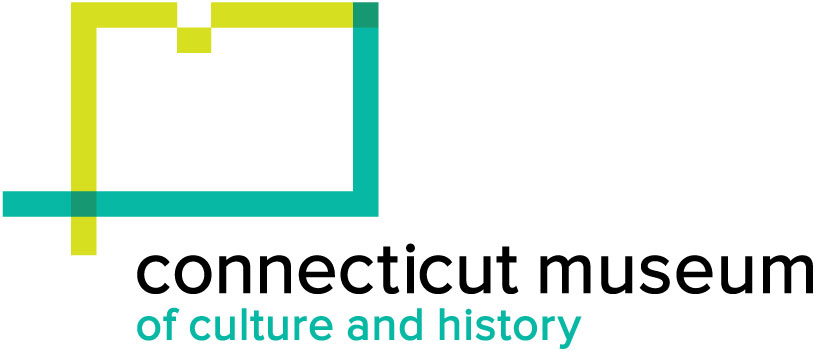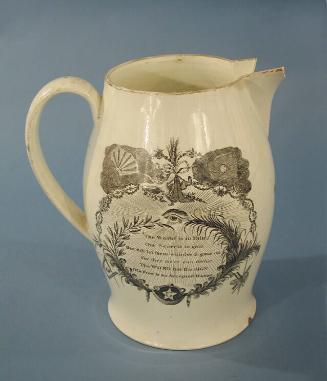Pitcher and Punch Bowl
Original OwnerOriginally owned by
Captain Robert Niles
(American, 1734 - 1818)
MakerMade by
Unknown
Date1800-1815
MediumWheel-thrown cream-colored earthenware with overglaze enamel decoration in black, green, red, blue, and yellow
DimensionsComponent (height x width x depth of pitcher): 7 1/4 x 7 3/4 x 4in. (18.4 x 19.7 x 10.2cm)
Component (height x diameter of punch bowl): 4 3/4 x 11in. (12.1 x 27.9cm)
ClassificationsCeramics
Credit LineGift of Hannah F. Niles
Object number1865.1.0a,b
DescriptionRound punch bowl and barrel-shaped pitcher of cream-colored earthenware, a type of ceramic known as creamware. Both the punch bowl and pitcher are decorated with black transfer-printed designs with patriotic and naval images. Additionally, one design on the punch bowl has been hand-painted with enamel.
Pitcher (.a): The pitcher is known as a "Liverpool pitcher" because many creamware pitchers of this shape with black printed designs were known to have been made and exported to America from Liverpool, England. The pitcher has a flat base, swelled sides, and a narrower rim, with a spout opposite a molded and applied handle. There are two black transfer-printed designs and one set of initials on the outside of the pitcher. The first design, printed to the left of the handle, shows an oval map of North and South America. To the right of the map are two blindfolded standing female figures behind a seated gentleman holding a book. To the left of the map is a standing male figure in eighteenth-century dress and a standing woman in Grecian clothing. Hovering to the left, above the standing man and woman, is a winged figure with a trumpet in its mouth. There is a flag above the globe. These are all surrounded by a circular border, with six small names written next to numbers that correspond to the figures in the design. These are "1 Washington/ 2 Liberty", referring to the standing man and the woman in Grecian costume, "3 Fame", referring to the winged figure blowing the trumpet, "4 Minerva/ 5 Fortune", referring to the two standing women with blindfolds, and, "6 Dr. Franklin" referring to the seated gentleman with a book. The design to the right of the handle consists of an oval with the following words inside "As he tills the rich globe the old peasant shall tell,/ While his bosom with Liberty glows;/ How your WARREN expir'd, how MONTGOMERY fell,/ And how WASHINGTON humbled your foes". The oval area is surrounded by symbols of liberty, including a flag, liberty cap, wreaths, and flowers. A banner below the oval contains the word "INDEPENDENCE". Finally, the initials "RN" are transfer-printed in an elaborate script below the spout. There are several small chips in the rim of the pitcher and a few spots of crazing above the oval design containing the poem.
Punch Bowl (.b): The round punch bowl has a relatively high foot and is decorated on both the inside and outside with a series of black transfer-printed designs. There are four designs on the outside of the punch bowl. The first consists of an eagle with outstretched wings, with a body composed of a shield, holding a banner in its mouth with the words "PLURIBUS UNUM" and thirteen stars above. The second design shows a man in an eighteenth-century military uniform riding a horse in the foreground while a battle commences in the background. Words below the scene state "His Excellency General George Washington, Marshal of France/ & Commander in chief of all the North American Continental Forces". The third design shows an image of a man wearing a fur hat. The man's official title is found written in scrolls to the left and write of the image: "BENJ.M FRANKLIN" and "L.L.D. F.R.S." Below this the design states "Born at Boston in New England 17 Jan 1706". The fourth and final oval design on the outside of the punch bowl shows a man in late eighteenth- or early nineteenth-century military uniform, holding a sword, and standing on the body of a lion. A ship floats in the body of water in the background on the right. Three soldiers stand at attention in the background on the left. The oval is surrounded by a relatively plain border with a few motifs representing liberty emerging from the top edge. These motifs include a liberty cap, trumpet, flag, rifle, and a spear. Below the oval, two wreaths curve up around the oval. A small pile of ordinance, cannons, cannon balls, and a barrel of powder, appear where the two wreaths meet. A banner circles this entire design and contains the following words: "BY VIRTUE AND VALOUR, WE HAVE FREE'D OUR COUNTRY, EXTENDED OUR COMMERCE, AND LAID THE FOUNDATION OF A GREAT EMPIRE". There are a series of designs printed along the inside edge of the rim, and one large design printed on the inside bottom of the punch bowl. Six different designs are printed along the inside edge of the rim, each consisting of a grouping of objects relating to patriotism and building the country. Objects printed here include a cannon and cannonballs, drafting and measuring eqipment, a globe, a crown, and ships' sails, among others. These objects are arranged in groupings that reflect the neoclassical style popular during the early nineteenth century. The large design printed in the center of the punch bowl consists of a sailing ship with at least three masts and an American flag. The ship floats in a sea hand-colored with green enamel, and the flags have been hand-colored as well. Below this are the initials "RN". Just below the initials, several cracks emanate from a chip in the ceramic, probably a spot where the bowl received an impact. This corresponds to an area on the outside of the bowl where two or three chips have almost broken off. There are several small rough spots along the rim where the glaze has chipped or worn away.
NotesHistorical and Subject Note: Captain Robert Niles (1734-1818) of Groton, Connecticut, was a privateer who commanded the schooner "Spy" during the American Revolution. According to a note in the Hartford Courant published 14 June 1865 the bowl "has the initials R. N. with a vessel under sail, bearing the American flag - suposed [sic] to represent the 'Spy' ..." (Hunt 10/25/2004)Pitcher (.a): The pitcher is known as a "Liverpool pitcher" because many creamware pitchers of this shape with black printed designs were known to have been made and exported to America from Liverpool, England. The pitcher has a flat base, swelled sides, and a narrower rim, with a spout opposite a molded and applied handle. There are two black transfer-printed designs and one set of initials on the outside of the pitcher. The first design, printed to the left of the handle, shows an oval map of North and South America. To the right of the map are two blindfolded standing female figures behind a seated gentleman holding a book. To the left of the map is a standing male figure in eighteenth-century dress and a standing woman in Grecian clothing. Hovering to the left, above the standing man and woman, is a winged figure with a trumpet in its mouth. There is a flag above the globe. These are all surrounded by a circular border, with six small names written next to numbers that correspond to the figures in the design. These are "1 Washington/ 2 Liberty", referring to the standing man and the woman in Grecian costume, "3 Fame", referring to the winged figure blowing the trumpet, "4 Minerva/ 5 Fortune", referring to the two standing women with blindfolds, and, "6 Dr. Franklin" referring to the seated gentleman with a book. The design to the right of the handle consists of an oval with the following words inside "As he tills the rich globe the old peasant shall tell,/ While his bosom with Liberty glows;/ How your WARREN expir'd, how MONTGOMERY fell,/ And how WASHINGTON humbled your foes". The oval area is surrounded by symbols of liberty, including a flag, liberty cap, wreaths, and flowers. A banner below the oval contains the word "INDEPENDENCE". Finally, the initials "RN" are transfer-printed in an elaborate script below the spout. There are several small chips in the rim of the pitcher and a few spots of crazing above the oval design containing the poem.
Punch Bowl (.b): The round punch bowl has a relatively high foot and is decorated on both the inside and outside with a series of black transfer-printed designs. There are four designs on the outside of the punch bowl. The first consists of an eagle with outstretched wings, with a body composed of a shield, holding a banner in its mouth with the words "PLURIBUS UNUM" and thirteen stars above. The second design shows a man in an eighteenth-century military uniform riding a horse in the foreground while a battle commences in the background. Words below the scene state "His Excellency General George Washington, Marshal of France/ & Commander in chief of all the North American Continental Forces". The third design shows an image of a man wearing a fur hat. The man's official title is found written in scrolls to the left and write of the image: "BENJ.M FRANKLIN" and "L.L.D. F.R.S." Below this the design states "Born at Boston in New England 17 Jan 1706". The fourth and final oval design on the outside of the punch bowl shows a man in late eighteenth- or early nineteenth-century military uniform, holding a sword, and standing on the body of a lion. A ship floats in the body of water in the background on the right. Three soldiers stand at attention in the background on the left. The oval is surrounded by a relatively plain border with a few motifs representing liberty emerging from the top edge. These motifs include a liberty cap, trumpet, flag, rifle, and a spear. Below the oval, two wreaths curve up around the oval. A small pile of ordinance, cannons, cannon balls, and a barrel of powder, appear where the two wreaths meet. A banner circles this entire design and contains the following words: "BY VIRTUE AND VALOUR, WE HAVE FREE'D OUR COUNTRY, EXTENDED OUR COMMERCE, AND LAID THE FOUNDATION OF A GREAT EMPIRE". There are a series of designs printed along the inside edge of the rim, and one large design printed on the inside bottom of the punch bowl. Six different designs are printed along the inside edge of the rim, each consisting of a grouping of objects relating to patriotism and building the country. Objects printed here include a cannon and cannonballs, drafting and measuring eqipment, a globe, a crown, and ships' sails, among others. These objects are arranged in groupings that reflect the neoclassical style popular during the early nineteenth century. The large design printed in the center of the punch bowl consists of a sailing ship with at least three masts and an American flag. The ship floats in a sea hand-colored with green enamel, and the flags have been hand-colored as well. Below this are the initials "RN". Just below the initials, several cracks emanate from a chip in the ceramic, probably a spot where the bowl received an impact. This corresponds to an area on the outside of the bowl where two or three chips have almost broken off. There are several small rough spots along the rim where the glaze has chipped or worn away.
Subject Note: The image of the military officer standing over the lion is probably a symbol of America's victory against England during the American Revolution. The Lion is the symbol England. (Hudson 10/25/2004)
Status
Not on viewNicholas J. Bogert



















